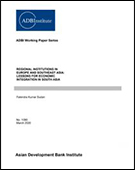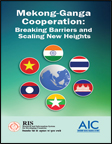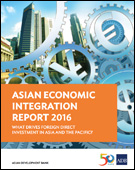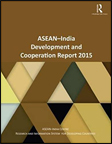Assam as India's Gateway to ASEANAssam's location in northeast India offers opportunities for enhancing cross-border trade and developing regional economic corridors spanning Bangladesh, Bhutan, India, Nepal, and countries in Southeast Asia. By developing trade and economic corridors, Assam aims to build on its vision of becoming a $75 billion economy by 2025. Author: Asian Development Bank Year: 2021 Download Tags: ASEAN, Bangladesh, Bhutan, India, Nepal, Regional Cooperation, Trade, ADB RCI  Regional Institutions in Europe and Southeast Asia: Lessons for Economic Integration in South AsiaThis working paper takes a look at the European Union (EU) and the Association of Southeast Asian Nations (ASEAN) as examples of regional institutions that were able to successfully foster economic growth and competitiveness. More specifically, the paper discusses the economic achievements of regional integration within the ASEAN and compares it with the EU. It offers lessons from the ASEAN integration that could help accelerate South Asian regional integration. It also examines the political and economic barriers hindering economic integration in South Asia, and emphasizes potential benefits regional integration and economic cooperation could bring to the South Asian Association for Regional Cooperation (SAARC) region. These include reduced economic dependence on developed countries, increased trade, and stronger economic growth in the SAARC region. Author: Falendra Kumar Sudan Year: 2020 Download Tags: Regional Cooperation, Economic Cooperation, EU, ASEAN, ADB RCI BIMSTEC and Japan: Exploring Prospects for Renewed CooperationThe Bay of Bengal region is rising as an economic and strategic hub, with the Bay of Bengal Initiative for Multi-Sectoral Technical and Economic Cooperation (BIMSTEC) playing a key role in promoting growth and development in the region. BIMSTEC is also being seen as a potential driver of integration between South Asia and Southeast Asia. Given Japan's relationship with BIMSTEC nations, this brief makes a case for deeper engagement between Japan and BIMSTEC. The benefits could include cooperation in infrastructure, connectivity, and energy projects. A free trade agreement between the two entities would also be mutually beneficial. Author: Vindu Mai Chotani Year: 2018 Download Tags: ASEAN, Bangladesh, Bhutan, BIMSTEC, Connectivity, India, Myanmar, Nepal, Sri Lanka, Free Trade Agreements Services and Global Value Chains: The Asia-Pacific Reality, Studies in Trade, Investment and Innovation 89This book reviews issues concerning the roles of services in global value chains. It presents a framework for assessing links among different services and between services and the manufacturing sector. The book explains the contribution of services to global value chains in the Asia-Pacific region and to the world and also draws lessons with which countries could understand the importance of services and participation in global value chains to achieving sustainable development. Author: Witada Anukoonwattaka, Mia Mikic, Yuhua Zhang Year: 2017 Download Tags: ASEAN, Asia-Pacific, Energy, Global Value Chains, India, Nepal, Regional Cooperation, Sri Lanka, Sustainable Development, Sustainable Development Goals, Trade Facilitation, UNESCAP Asia-Pacific Trade and Investment Report 2017: Channelling Trade and Investment into Sustainable DevelopmentThis report provides analyses of trends and policy developments in trade in goods and commercial services in Asia-Pacific. It shows that merchandise trade remained subdued in 2016, with South and Southwest Asia accounting for 8% of Asia-Pacific exports and 12% of Asia-Pacific imports. Foreign direct investments inflows In South and South-West Asia decreased slightly by 4% to $66 billion in 2016. The report also argues for targeted trade and investment policies that strike a balance between economic development and social and environmental development. Author: United Nations Economic and Social Commission for Asia and the Pacific Year: 2017 Download Tags: Trade, Investment, FDI, ASEAN, India, Services, South Asia, Sri Lanka, Sustainable Development Goals, UNESCAP ESCAP Newsletter - 2017 SeptemberThe ESCAP Newsletter is a monthly recap of the events and other activities of the United Nations Economic and Social Commission for Asia and the Pacific (UNESCAP). This issue highlights the ASEAN-India partnership and how it could benefit the Asia-Pacific region. Dr. Shamshad Akhtar, Executive Secretary, UNESCAP, talks about the importance of sustainable development and regional cooperation and integration. The issue also features a story on strengthening technical cooperation between UNESCAP and Myanmar. Author: United Nations Economic and Social Commission for Asia and the Pacific Year: 2017 Download Tags: ASEAN, India, Myanmar, Regional Cooperation, Regional Integration, UNESCAP The Asian Economic Integration Cooperation Agreement: Lessons for Economic and Social DevelopmentThis paper focuses on the impact of regional integration on development and poverty reduction in the Association of Southeast Asian Nations (ASEAN) economic community. It examines economic growth, rapid trade, and investment expansion and looks at challenges presented by the deterioration in trade balances in Cambodia, Laos, Myanmar, and Vietnam. It also explores the role of regional integration in addressing the development gap in ASEAN countries. Author: Amelia U. Santos-Paulino Year: 2017 Download Tags: ASEAN, Free Trade Agreements, Least Developed Countries, Myanmar, Regional Cooperation, Regional Integration, WTO Myanmar’s Engagement in Regional Integration: Status and Way Forward (AWP No. 169)Myanmar strategic position connects Asia’s three big markets—Association of Southeast Asian Nations, China, and India. Since 2011, Myanmar has laid down economic reforms that are unlocking the country’s potential. This working paper discusses Myanmar’s participation in regional partnerships, such as the South Asia Subregional Economic Cooperation, which it joined in 2017. It argues that such partnerships are essential in building Myanmar’s infrastructure and speeding up its growth. Author: Prabir De Year: 2017 Download Tags: ADB, ASEAN, India, Myanmar, Regional Cooperation, Regional Integration, SASEC, UNESCAP Digital Trade Facilitation: Paperless Trade in Regional Trade AgreementsMost regional trade agreements now feature one or more measures for electronically exchanging trade-related information. These measures are becoming essential to maintaining trade competitiveness and enabling effective participation in cross-border e-commerce. This paper examines the extent to which measures enabling paperless trade are included in regional trade agreements (RTAs), such as the Association of Southeast Asian Nations-India Free Trade Agreement. India leads the region with the highest number of RTAs involving paperless trade measures. Asia-Pacific RTAs now increasingly cover specific areas of paperless trade such as electronic certificates of origin and sanitary and phytosanitary certificates. Author: Yann Duval and Kong Mengjing Year: 2017 Download Tags: ADB, ASEAN, Free Trade Agreements, India, Regional Cooperation, Trade Facilitation, UNESCAP, WTO  Mekong-Ganga Cooperation: Breaking Barriers and Scaling New HeightsThe Mekong-Ganga Cooperation (MGC) promotes intra-regional collaboration among Cambodia, India, Lao PDR, Myanmar, Thailand and Vietnam in the areas of trade, tourism, culture, education, and transport and communications. This book reviews how MGC cooperation has grown since MGC's inception in 2000, including expansion of their economic and cultural relations. Under India's Act East Policy, MGC has gained further momentum – endorsing a Plan of Action 2016-2018, and planning extended connectivity of the India-Myanmar-Thailand Trilateral Highway to Cambodia, Laos, and Vietnam. This report outlines important discussion points on trade, regional value chains, foreign direct investment, physical and digital connectivity, border connectivity, and cultural relations, to strengthen India and the Association of Southeast Asian Nation linkages through MGC. Author: Research and Information System for Developing Countries and ASEAN-India Centre Year: 2017 Download Tags: ASEAN, India, Southeast Asia, South Asia, Trade, Trade Facilitation  Asian Economic Integration Report 2016: What Drives Foreign Direct Investment in Asia and the Pacific?The 2016 Asian Economic Integration Report reviews regional economic cooperation and integration in Asia and the Pacific, amidst the rising global uncertainty following the United Kingdom’s referendum on leaving the European Union and the U.S. election, slower-than-expected global economic recovery, and ongoing economic restructuring in the People’s Republic of China and growth moderation. Asia faces heightened uncertainty–trade growth decelerated in 2015, falling to 2.3% in 2015; subregional trade linkages continue to strengthen, but inter-subregional trade linkages weakened; and non-tariff measures have become major obstacles to trade. In South Asia, SASEC cooperation has improved access to key markets in smaller economies, reduced real trade costs and behind-the-border barriers to stimulate investment; and enabled cross-border power exchanges to ensure power supply affordability, reliability, and overall grid stability. However, the SASEC agenda needs to be framed within wider integration processes taking place in Asia in the next decade to enhance economic linkages, and harness the full potential of Asian integration. Author: Asian Development Bank Year: 2016 Download Tags: ADB, ASEAN, Asia-Pacific, Development, FDI, Free Trade Agreements, Regional Cooperation, Regional Integration, SASEC, Trade Facilitation, UNCTAD, Bangladesh, Bhutan, India, Maldives, Nepal, Sri Lanka Asia-Europe Connectivity Vision 2025: Challenges and OpportunitiesThe 11th Asia-Europe Meeting (ASEM) Summit held in Mongolia in 2016 saw ASEM member countries renew their commitments for deepened engagement between Asia and Europe. This report on the Summit provides ideas for an ASEM roadmap for connectivity, recognizing the need for sustainability and scalability. The report draws lessons from efforts by the Association of Southeast Asian Nations to bring together peoples, goods, services, and capital. ASEM, an intergovernmental forum for dialogue and cooperation, comprises 53 member countries, including India and Bangladesh. Author: Anita Prakash, editor Year: 2016 Download Tags: ASEAN, India, Bangladesh, Connectivity South Asian Approach to Sustainable Development Goals: Trade Insight Vol. 12, No. 1, 2016The paper, published by South Asia Watch on Trade, Economics and Environment, situates the challenges of implementation of the Sustainable Development Goals (SDGs) in the South Asian context. Noting that the delivery of the Millennium Development Goals in the region had been quite uneven, the paper examines the potential for regional cooperation to better achieve the SDGs. The paper then tries to chart a South Asian pathway for SDGs implementation and put forward some concrete proposals for South Asian countries. Author: Debapriya Bhattacharya and Umme Shefa Rezbana Year: 2016 Download Tags: ASEAN, India, Economic Integration Celebrating the Third Decade and Beyond: New Challenges to ASEAN-India Economic PartnershipThe relationship between ASEAN and India is set to deepen as ASEAN and India step up their collaboration across a range of economic and strategic issues, including trade and connectivity, culture, people-to-people links, trans-national terrorism, and maritime security. This book seeks to review the past and suggest ways to further strengthen economic partnership between ASEAN countries and India. It primarily deals with the economic integration issues between ASEAN and India, and assesses policy priorities, effectiveness, implementation imperatives and challenges. The book tries to capture essential features of cross-cutting issues and attempts to draw policy implications. Author: KW Publishers Year: 2016 Download Tags: ASEAN, India, Connectivity ASEAN-India Air Connectivity ReportAir connectivity plays an important component in India’s connectivity agenda with the Association of Southeast Asian Nations (ASEAN). This ASEAN-India Air Connectivity Report addresses issues and challenges concerning air connectivity between India and ASEAN, including constraints and bottlenecks hindering growth of air cargo that would help unlock trade potential. With India embarking on “Make in India” and “Skill India” policies, stronger air connectivity has become all the more important in the context of India’s drive for economic integration with its neighbors in the east. Author: ASEAN-India Centre and Research and Information Centre for Developing Countries Year: 2016 Download Tags: Transport, ASEAN, India, Manufacturing  ASEAN-India Development and Cooperation Report 2015Re-engagement between India and ASEAN through increased cooperation across a range of issues, including trade and connectivity, is set to boost prosperity, competitiveness, growth and integration. With negotiations underway to establish a comprehensive free trade area through the Regional Comprehensive Economic Partnership, economic integration between India and Southeast and East Asia is set to scale new heights – further highlighting need for economic corridors with adequate cross-border infrastructure facilities that could facilitate increased production and services networks between ASEAN and Indian economies. This Report brings together experts and researchers who weigh in on ASEAN-India relations, analyzing the impact and implications of integration; assessing policy priorities, effectiveness, implementation imperatives and challenges; and discussing themes central to the economic sustainability of the region. Author: ASEAN–India Centre, Research and Information System for Developing Countries Year: 2015 Download Tags: ASEAN, India, Trade, Trade Facilitation Trans-Pacific Partnership versus Regional Comprehensive Economic Partnership: Control of Membership and Agenda Setting This ADB Working Paper argues that the formation of regional integration frameworks can be best understood as a dominant state’s attempt to create its own regional framework where it can exercise some exclusive influence. It explores the Trans-Pacific Partnership and the Regional Comprehensive Economic Partnership (RCEP). It also analyzes the strategies of key players such as ASEAN, Korea, India, Japan, USA and China. India is part of the RCEP negotiating process and sees increased presence in Southeast and East Asian markets, closer relations with ASEAN, and increased connectivity with North Asia and Oceana as benefits from involvement in RCEP. Author: Asian Development Bank Year: 2014 Download Tags: Regional Integration, India, Connectivity, ADB, Regional Cooperation, ASEAN Asian Economic Integration Monitor: November 2014This AEIM review of recent economic performance highlights the need for Asia to rebalance its sources of growth toward domestic and regional demand. It also shows a resilient Asia with rising GDP growth in South Asia. This issue includes a Special Chapter: Regional Financial Integration and Crisis in Asia and Europe – A Comparative Analysis. It presents Asia’s future path of integration as different from that in Europe. Asia will continue to strengthen efforts to harmonize rules and regulations in the financial sector and further unilateral trade and investment, while Europe is more likely to strengthen regional institutions to ensure recovery and better the monetary union. Author: Asian Development Bank Year: 2014 Download Tags: Asia-Pacific, Economic Integration, Europe, ASEAN, Bangladesh, Bhutan, India, Maldives, Nepal, Regional Integration, Sri Lanka, Trade Facilitation, Transport ASEAN, PRC, and India: The Great TransformationThis joint study by the Asian Development Bank and the Asian Development Bank Institute highlights the Association of Southeast Asian Nations, the People’s Republic of China, and India (collectively referred to as ACI economies) as drivers of the global economy. It explores links among ACI economies and how these may shape regional and global competition and cooperation. The study also notes that Asia’s leading economies can foster a positive outcome through a paradigm shift toward inclusive, green, and knowledge-led growth. Adoption of low-carbon, green growth strategies can help place ACI economies on a sustainable growth path. Furthermore, infrastructure and human capital investments can link ACI economies through region-wide free trade and investment agreements. Author: Asian Development Bank and Asian Development Bank Institute Year: 2014 Download Tags: India, Asia-Pacific, Regional Cooperation, ADB, ASEAN, Investment  The Merits of Regional Cooperation: The Case of South AsiaThis book makes the case for a re-strengthened South Asian Association for Regional Cooperation (SAARC), arguing that regional integration is a key factor for countries in South Asia to succeed economically and increase confidence among potential foreign investors. SAARC's inroads in improving border crossings, transport routes, and infrastructure are improving weak levels of trade within the region. However, these efforts are insufficient; they need to go hand-in-hand with further improving bilateral relations – and SAARC is in a good position to facilitate these negotiations. Spanning a wide range of subjects, including international relations, strategic affairs, environment, politics and economic issues, the publication aims to show the huge potential of South Asia as a region. Author: Siegfried O. Wolf, Paulo Casaca, Anne J. Flanagan, and Cátia Rodrigues Year: 2014 Download Tags: Regional Cooperation, ASEAN, Bangladesh, Europe, India, SAARC, South Asia Simulating World Trade in the Decades Ahead: Driving Forces and Policy ImplicationsThis working paper considers economic prospects up to the year 2100, offering assumptions about key exogenous variables, providing a baseline for climate change policy evaluation, and discussing sectoral and trade issues. The paper combines an economic growth model with a multi-sectoral model to construct scenarios for around 150 countries up to a maximum time horizon of 2035, with forecasts on a number of key variables such as energy prices, demographics, etc. It suggests that trends toward increased regionalization may be reversed, with multilateral trade relationships gaining in importance. Author: Lionel Fontagné, Jean Fouré and Alexander Keck Year: 2014 Download Tags: Climate, Trade, Statistics, Trade Policy, Policy, Energy, Tariff, ASEAN, India, Environment Potential Growth in Emerging AsiaThis paper estimates potential growth for China, India, and five ASEAN countries during 1993-2013. It states that India has exhibited a slowdown in potential growth, reflecting a decline of total factor productivity growth. The paper also puts forward that demographic factors will be much more supportive in the future as the working-age population starts to decrease. Author: Rahul Anand, Kevin Cheng, Sidra Rehman, Longmei Zhang Year: 2014 Download Tags: Economics, India, ASEAN, Trade The ASEAN Economic Community: A Work in ProgressThis publication explores the barriers and impediments to the realization of an ASEAN Economic Community (AEC), and to what extent its self-imposed deadline of 2015 for achievement of an AEC is more of a milestone of progress than a firm target. It examines whether the AEC is achievable, the obstacles faced in achieving it, and the measures required to help it become a reality. Author: Asian Development Bank Year: 2013 Download Tags: Regional Cooperation, Regional Integration, Trade Policy, ASEAN, Economic Integration, Regional Cooperation, ADB, Regional Integration, Services, Global Value Chains, Non-Tariff Measures, Asia-Pacific Trade Agreement, India, Trade Facilitation Emerging Asian Regionalism-A Partnership for Shared ProsperityThe study summarizes important issues related to Asian regionalism. Viewing regional cooperation as a necessary tool for coping with the consequences of interdependence, the book discusses several pressing issues, such as integrating production, improving financial cooperation, and managing macroeconomic interdependence to create a stable architecture for an Asia-wide cooperation. Author: Asian Development Bank Year: 2008 Download Tags: Economic Corridor, Regional Cooperation, Regional Integration, Asia, ASEAN, SAARC, Bangladesh, Bhutan, India, Nepal, Maldives, Sri Lanka |



